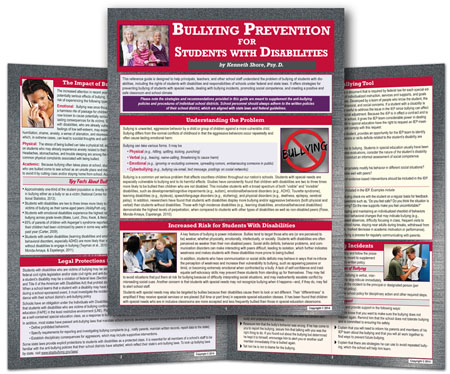School is now back in session in districts across the country. Unfortunately, a return to school also means a return to being bullied for many students, especially students with disabilities. Last week a particularly heinous example of bullying of a student with special needs was widely disseminated in a viral video of a student with autism whose peers told him he was nominated to take the ALS ice bucket challenge and proceeded to dump a bucket of urine and feces (instead of ice water) on his head.
 We would all like to believe that this outrageous case is an outlier, but the truth is, students with disabilities are frequently the targets of bullies. In fact, they are estimated to be two to three times as likely to be the victims of bullying as their same-aged peers. As the “ice bucket” prank demonstrates, bullying can take a variety of forms. It is not limited to physical violence; indeed, as the “ice bucket” incident so painfully shows, other forms of bullying such as humiliating (through cruel pranks, making a student the butt of jokes, name calling, etc.) or ostracizing someone, can be even more traumatic than physical assault.
We would all like to believe that this outrageous case is an outlier, but the truth is, students with disabilities are frequently the targets of bullies. In fact, they are estimated to be two to three times as likely to be the victims of bullying as their same-aged peers. As the “ice bucket” prank demonstrates, bullying can take a variety of forms. It is not limited to physical violence; indeed, as the “ice bucket” incident so painfully shows, other forms of bullying such as humiliating (through cruel pranks, making a student the butt of jokes, name calling, etc.) or ostracizing someone, can be even more traumatic than physical assault.
While it will come as no surprise to those who work in the schools that students with disabilities are frequent targets of bullying, it is less well known that students with certain disabilities-especially ADHD, emotional/developmental disabilities, and learning disabilities-are more likely to perpetrate bullying than their non-disabled peers.
 Although bullying disproportionately affects students with disabilities, educators and school personnel have a variety of powerful tools available to them for stopping and preventing bullying of students with disabilities. One of the most powerful tools is the IEP (individual education program). If behaviors or skills deficits related to a student’s disability are contributing to the child being bullied or bullying others, evidence-based interventions and additional supports can be incorporated into the student’s IEP.
Although bullying disproportionately affects students with disabilities, educators and school personnel have a variety of powerful tools available to them for stopping and preventing bullying of students with disabilities. One of the most powerful tools is the IEP (individual education program). If behaviors or skills deficits related to a student’s disability are contributing to the child being bullied or bullying others, evidence-based interventions and additional supports can be incorporated into the student’s IEP.
Dr. Kenneth Shore, an authority on bullying prevention, has written the quick-reference laminated guide Bullying Prevention for Students with Disabilities to help educators-including principals, teachers, guidance counselors, and other school staff-recognize, respond to, and prevent bullying of students with special needs. It also offers guidance on promoting social competence, and creating a positive and safe classroom and school climate, which benefits all students. The guide, published by National Professional Resources, is available at http://www.nprinc.com/bullying-prevention-for-students-with-disabilities/.








